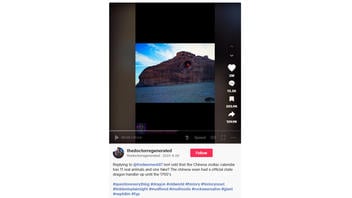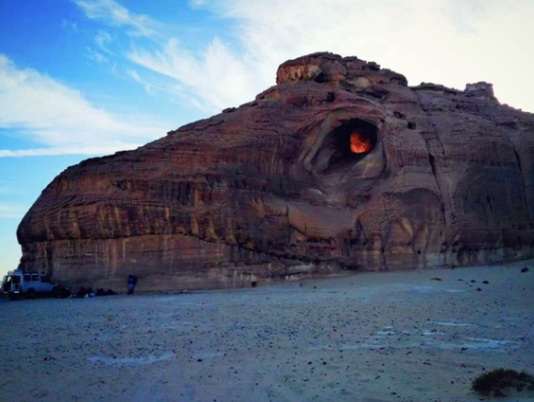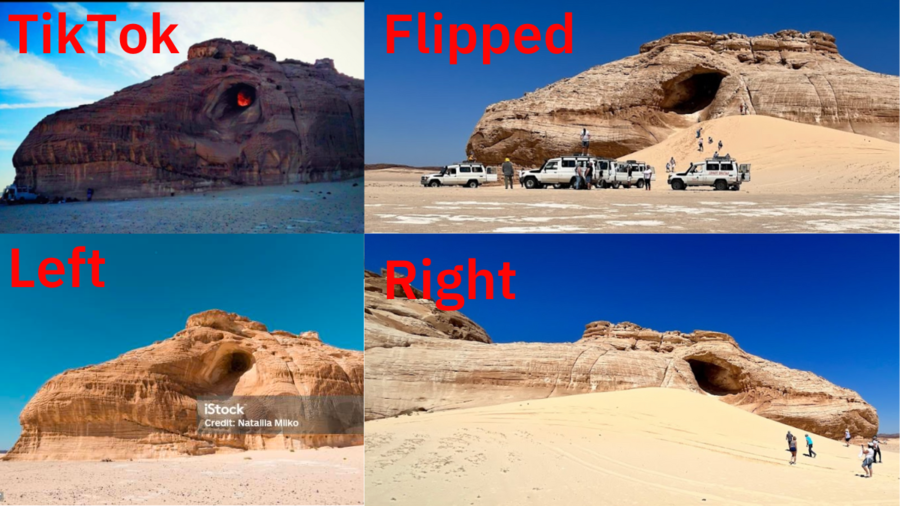STORY UPDATED: check for updates below.

Does a photo show the genuine "mud fossil remains" of the "dragon head cave in Egypt," as a video on TikTok claims? No, that's not true: The theory of "mud fossils" is a pseudoscientific notion, and there is no evidence that dragons were real. The image's photographer confirmed to Lead Stories that it showed a geological feature in Egypt's Mount Sinai region.
The claim originated in a video shared to TikTok on September 27, 2023, (archive) with a caption that read:
Replying to @fredwerner687 Isnt odd that the Chinese zodiac calendar has 11 real animals and one fake? The chinese even had a official state dragon handler up until the 1700's
#questioneverything #dragon #oldworld #history #historyreset #hiddeninplainsight #mudflood #mudfossils #rockswerealive #giant #nephilim #fyp
Below is a screenshot from the clip as it appeared at the time of writing:
(Source: TikTok screenshot taken Wed March 6 07:25:00 UTC 2024)
At the 59-second mark in the video, the narrator in the video states:
And you can still find mud fossil remains, like here's the dragon head cave in Egypt.
The above image was presented as evidence of a so-called "mud fossil" with the implication that it preserved a dinosaur head. Mud fossils are based on a pseudoscience theory put forward by Roger Spurr, who claims (archive) in a book synopsis on Amazon to have "DNA and cat scan tests performed which completely validated the specimens" of so-called "mudfossils." This claim is promoted on Spurr's YouTube channel, Mudfossil University (archive), which argues that large animals and creatures were preserved due to "mud and wet conditions during the Great Flood." There is no legitimate evidence to corroborate the validity of the mud fossil theory.
There is also no evidence that dragons are or have ever been real, according to a University of Florida blog (archive) with an interview of Rachel Keeffe (archive), a reptile and amphibian researcher. Keeffe stated:
Unfortunately, no, we do not have evidence of dragons on this planet. We do have evidence of very cool extinct animals that were kind of similar to dragons, but no fire-breathing six-legged vertebrates, I'm afraid.
In a nutshell: dragon myths were likely inspired by real animals, natural phenomena, or historical events around the world, but we have no empirical evidence for the existence of dragons as they are depicted in mythology. Some real reptiles are named after dragons, but I'm afraid most folks would be disappointed to hear that Komodo dragons cannot actually breathe fire or fly.
As the American Museum of Natural History Museum noted (archive), dragons have been observed in folklore globally for centuries. However, there is no evidence that they existed:
With their enormous size, reptilian shape and threatening teeth and claws, some dragons might easily be taken for cousins of Tyrannosaurus rex. Living dinosaurs did not inspire the dragon idea--they died out long before people were around to observe them. But the fossil remains of extinct animals have sometimes been taken for dragon bones--and helped perpetuate old dragon stories.
The image in the video on TikTok appears to have been edited to include what looks to be a flame indicative of a dragon eye. A Google search of the keywords "Dragon Head Cave, Egypt" (archive) returned the same geological feature as above as seen in this iStock image (archive) and this Shutterstock image (archive).
Natalia Milko was listed as the image photographer. In an email received on April 11, 2024, Milko confirmed to Lead Stories that she captured the photograph in May 2023.
"This mountain is situated in South Sinai, around one hour drive from Dahab village in Egypt. There is no exact location, it's in the middle of nowhere in Sinai desert, local Bedouin people know how to reach it," wrote Milko, who said that she has visited the location a "couple of times."
A reverse image search of the stock images using Yandex (archive) revealed a photo in the Mackhroum Mountain area in Egypt. Images on Google Earth (archive) of this region show similarities between the image shared in the video on TikTok, including the shape of the eye and geological formations on top of the "head." Though the images below are not identical matches, these differences can be explained by the angle or positioning of a photographer, as well as erosion or other weather-related changes that occur over time.
(Source: Lead Stories compilation)
Read more
Other Lead Stories fact checks related to history can be read here.
Updates:
-
2024-04-11T17:06:42Z 2024-04-11T17:06:42Z Adds photographer confirming to Lead Stories that photo shows geological feature in Egypt.



















